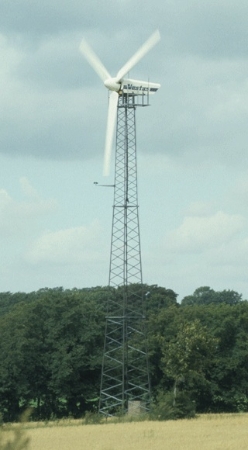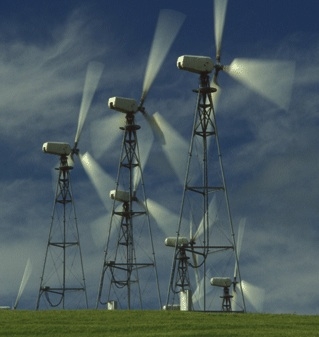Size Matters in Wind, But Only So Much
The wind turbine – standing tall, sleek and uniquely modern – is arguably the most powerful symbol of the technological advancement of renewables. And although size is typically the metric for such progress, it's the less visible improvements that have allowed the industry to grow.

-- Paul Gipe, Author and Wind Expert
As the turbines have gotten larger and more sophisticated, wind power has become the fastest-growing energy source in the world, with 37.5 gigawatts (GW) of capacity added last year. The Global Wind Energy Council expects wind to grow by 160% globally over the next five years, driven largely by bigger machines.
According to the Department of Energy's 2009 Wind Technology Report, the average size wind turbine installed in the United States in 2008 was 1.67 megawatts (MW) and the average project size was 83 MW. While the average size of projects was down from 120 MW in 2007 due to the financial crisis, the figures were still larger than any other year. And in Europe, machines of 2 MW and above have accounted for more than half of total installations since 2005, according to Emerging Energy Research.
Any side-by-side comparison between “large” turbines of the past and present is astonishing.
 Take
the Vestas 33-kW turbine released in 1979: With a rotor diameter
of 10 meters, the machine looks like a toy compared with the
company's new 3-MW, 112-meter rotor diameter turbine. And these
newer 2 and 3-MW turbines are now being outdone by offshore
machines in the 5-10 MW range produced by companies like
Clipper,
Enercon and
REpower.
Take
the Vestas 33-kW turbine released in 1979: With a rotor diameter
of 10 meters, the machine looks like a toy compared with the
company's new 3-MW, 112-meter rotor diameter turbine. And these
newer 2 and 3-MW turbines are now being outdone by offshore
machines in the 5-10 MW range produced by companies like
Clipper,
Enercon and
REpower.
“I never imagined they'd get as big as they are. I look at the early machines now and they look like bicycles to me – they're just tiny,” says Benjamin Bell, President and CEO of Garrad Hassan North America.
A dramatic visual comparison can make it seem like the industry has taken nothing but leaps and bounds in size and technology improvements. But the transition – which occurred over decades of trial and error – has come from incremental improvements in technology rather than dramatic shifts, says Bell.
Wind Expert Paul Gipe agrees. As turbines reach 10 MW of capacity – and there are plans to go as high as 20 MW – he questions whether the industry needs to keep focusing on larger-size turbines.
“The wind turbines don't really need to get any larger. They're big enough,” says Gipe. “There's sometimes this obsession with going bigger and bigger and it's not necessarily the size turbine that matters as much.”
Gipe says the most important innovations in modern wind
turbines are features like variable speed generation and
sophisticated power electronics that allow wind farm operators
to regulate voltage. Without such systems, wind farms couldn't
get as large as they are today.
The story of Benjamin Bell's career offers an interesting glimpse at the importance of those features, as well as how wind technologies have moved from one company to another over the years, getting tweaked and refined along the way.
Bell got his start in the wind industry as a student at the University of Massachusetts in the mid-1970's where he helped design and construct one of the first modern commercial wind turbines in the U.S. The 25-kW machine, called the Wind Furnace 1 (WF-1), was built with features that are found on most wind turbines today: three fiberglass blades that “spilled” the wind, a variable-speed rotor that increased operational efficiency and the first SCADA system controlled by a room full of Apple IIe computers.
“There was a lot of experimentation...but a lot of the technology that was developed on those small machines is still in use today,” Bell says.
The generation of machines before the WF-1 were based on fixed-pitch, fixed-speed turbines produced in Denmark by agricultural manufacturers. While the so-called “Danish Concept” seemed rudimentary compared with this new device, the Danish wind turbines proved to be some of the most rugged machines ever built.
“If you look at what wind turbines survived over the years, it was the ones made in Denmark,” says Paul Gipe, who worked on many of the early turbines. “That was because of they took a bottom-up approach with farmers and agricultural companies developing them with off-the-shelf components.”
 In
the late 70's, with the U.S. and Denmark starting to compete
technologically, a company called U.S. Windpower was formed to
commercialize the WF-1. Bell went to work for the company, which
in 1980 developed the first wind farm in the world – a project
in New Hampshire made up of 20 30-kW turbines. The project ended
up failing. The wind resource was weak and the turbines kept
having problems.
In
the late 70's, with the U.S. and Denmark starting to compete
technologically, a company called U.S. Windpower was formed to
commercialize the WF-1. Bell went to work for the company, which
in 1980 developed the first wind farm in the world – a project
in New Hampshire made up of 20 30-kW turbines. The project ended
up failing. The wind resource was weak and the turbines kept
having problems.
With a federal investment tax credit for wind in place, the industry turned to Altamont Pass and Tehachapi, California, where around 1,500 MW of wind capacity was installed in the early 1980's. Many of the growing Danish manufacturers like Vestas, Bonus and Micon saw the opportunity and started pouring products into the American market.
U.S. Windpower saw the opportunity as well. Bell moved over to the west coast to help the company install and operate thousands of its 100-kW fixed-speed machines around California.
In the late 80's, however, the federal government let the tax credits for the industry expire and the wind market dried up. The European manufacturers went back to their home markets where there was policy support and continued refining the machines. Many of the American manufacturers and developers faded away or shrunk.
U.S. Windpower stayed in business and eventually spun off its wind assets into a new company called Kenetech Corporation. But without enough money to stand behind its warranties and service old turbines, Kenetech went bankrupt in the mid-90's.
 Unlike
some of the Danish companies, American manufacturers like
Kentech didn't exactly embody the spirit of incremental
improvements during the boom time. Many of them were so focused
on making big leaps in turbine sizes, they produced machines
that needed a lot of fixing.
Unlike
some of the Danish companies, American manufacturers like
Kentech didn't exactly embody the spirit of incremental
improvements during the boom time. Many of them were so focused
on making big leaps in turbine sizes, they produced machines
that needed a lot of fixing.
A large number of the Kenetech machines installed in the 80's are still operating today, but many of the turbines from American companies were taken down long ago.
“In California we had two types of wind turbines,” says Gipe. “We had the Danish pieces of equipment...and the other group of turbines from our [American] aeronautical engineers. And the ones that you see still turning today are the ones by the farmers.”
Although some of the American-made machines didn't last as long as the European machines, there were a number of technologies being developed at companies like U.S. Windpower and Kenetech that helped set the stage for the much larger wind farms to come.
When Kenetech went out of business in 1996, Bell was working for another manufacturer called Zond Energy Systems. The company ended up buying the rights to a Kenetech variable-speed patent that Bell helped develop at U.S. Windpower many years earlier.
By placing a voltage controller on each variable-speed machine to regulate the device's power output – and thus the line voltage – Bell and his team were able to remotely keep voltage levels on the grid stable. Without such a system, it was extremely difficult to power up a large wind plant in a weak grid environment, says Bell.
The Zond team started experimenting with this new system on a 170 MW wind farm in Iowa. When operators tried bringing more than 60 MW of capacity from the wind farm online, grid voltage would skyrocket and trip the entire project offline. But a SCADA-controlled selectable power system allowed an operator to sit in a control room in California and power up the wind farm in Iowa without raising grid voltage too high, or dropping it too low.
“That was the first Eurkea that we could control system voltage with this device,” Bell says. “We slowly went from backyard tinkering to full scale power plant production. It was amazing to be a part of.”
Zond Energy was eventually bought up by Enron in the late 90's. When Enron went bust in 2001, GE purchased Enron's wind assets, giving it a major stepping stone into the wind industry. And this decades-long “tinkering” at the University of Massachusetts, U.S Windpower, Kenetech and Zond Energy formed a crucial piece of the product line of GE, which is now one of the top wind manufacturers in the world.
With wind turbines getting ever-larger and reaching ever-higher penetration levels – 35,000 MW in the U.S. – many utilities now see these machines not as novelties, but as power plants that can help keep the grid stable, says Bell.
“That's really where all the machines are today,” he says. “That's the story of the industry. We just started out bootstrapping – experimenting over time until something worked.”
To hear more from a group of experts -- including
Benjamin Bell, Paul Gipe, Wind Technology Journalist Eize de
Vries and Small-Wind Guru Mick Sagrillo -- listen to the podcast
player, linked above.
Inside Renewable Energy is a weekly audio news program featuring stories and interviews on all the latest developments in the renewable energy industries.
 To subscribe or visit go to:
http://www.renewableenergyaccess.com
To subscribe or visit go to:
http://www.renewableenergyaccess.com